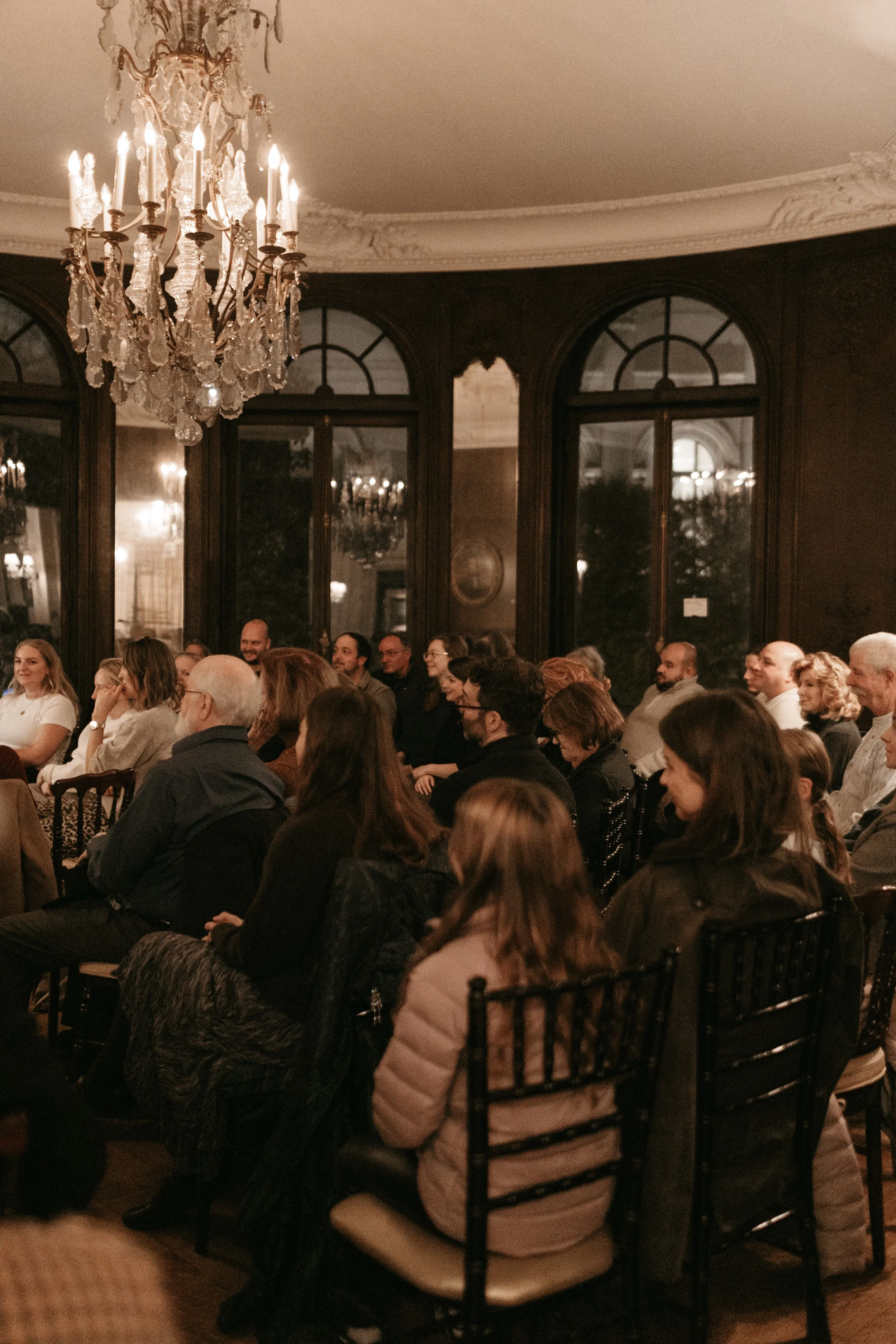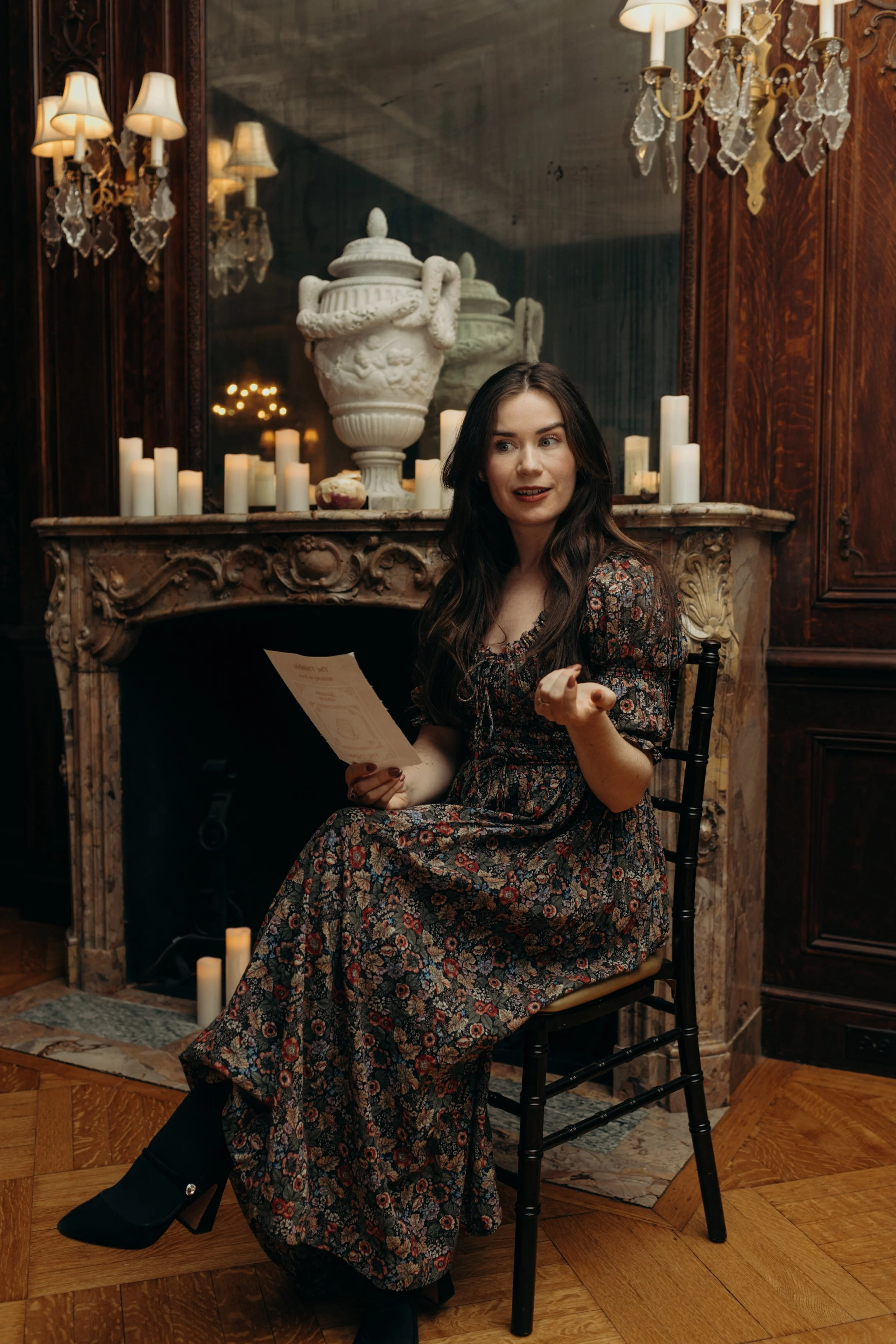Samhain in the City
I’m sitting in one of the last Gilded Age mansions still standing in the city, gazing around the music room. Dark wood panels are carved with ornate vines. The smokey crystal chandelier glitters from the plaster-medallioned ceiling. I’m surrounded by dozens of whispering people. We are all gathered around an ornate marble fireplace, occasionally glancing up at the carved turnip atop it, candle flickering inside.
We’re at the Irish American Historical Society, attending the second event for Hearth Ireland. Northern Irish actress and historian Susan Davey explains that Hearth “seeks to create spaces where a wide range of voices can be heard and stories shared.” Tonight, we will share ghost stories from Irish myth to more modern nightmares, bridging the old world and the new.
Tonight’s gathering, Samhain (pronounced “SOW-in”) – the Irish origins of Halloween – begins, and I feel like a stranger.
I have, if any, very few roots in Ireland; the white side of me is of the “sided with Mary Queen of Scots and got shunted off to America for being rowdy” variety. I don’t believe in ghosts or spirits or anything negative tied to the afterlife. But here I am, around a hearth, with Irish and Irish Americans, ready for ghost stories.
Susan greets us warmly in her lilting voice and asks, “What is Samhain?”
“A cross-quarter day.”
“It’s like Halloween.”
“The Celtic New Year.”
Turns out, it is all of these and more. She explains that Samhain marks the end of the harvest and the start of winter. In the old calendar, the year was divided into light and dark halves, and Samhain fell midway between the autumn equinox and winter solstice – literally “summer’s end.”
She begins with a Donegal tale of a quiet fisherman lured out to sea by the fae, saved at the last moment by a family friend. He’s never seen again. Other guests add stories: a farmer’s wife sees the silhouette of the Cailleach in the hills; a child hears the banshee’s wail. I was expecting to feel out of place, but it was cozy in the flickering dark, listening to centuries-old tales of fear and hope.
Samhain in Ireland is a fire festival. On this night fireworks explode, children wave sparklers, fathers singe their eyebrows, and community bonfires light the sky. After feasting on barmbrack – a speckled fruit loaf baked with charms – we pick at our slices to see what fate holds. Hidden inside are tiny trinkets: a ring promising love within a year, a thimble warning of spinsterhood, a coin for wealth, a matchstick for quarrelsome days. Children roam in disguises of banshees, witches, wolves and cats to confuse wandering spirits and avoid being snatched into the Otherworld.
One of the evening’s spookiest tales is of a restless spirit. A man dies violently and returns as a poltergeist, rattling beds, tapping ceilings and screaming in the attic. Neighbors stop calling; a priest’s attempted exorcism only enrages the entity. The family, shunned and starving, flee to America. At sea the captain scolds them for their children’s nocturnal hammering – but the children are asleep. Even across the ocean, the haunting never leaves their mother. I don’t have any family ghost stories, but this was something I could almost relate to: how such stories often reflect hardship and exile more than shock value. How some pains we carry forever.
Credit: Alexandra Cossack
The massive Bonfires are seen as a blessing. Great flames at harvest’s end that signal a time to rest from labor and reconnect with neighbors. To bring the blessing back to their home, families once carried the flaming embers from the communal fire to relight their hearths for the new year, carving faces into turnips to house the coals. The Celts believed the soul resided in the head rather than the heart; a turnip lantern, alive with the bonfire’s spirit, was a charm against misfortune.
A woman in the audience shares a modern vision: crossing Times Square, she sees a man pushing a bike toward the Apple store, eyes glued to his phone, oblivious as traffic surges. He drifts through cars unharmed and into the glass cube. In a city built on another continent’s stories, even our busiest streets hold ghosts, reminding us to look up.
Many traditions were lost during the great emigration of 1845–1855. Thousands were buried in mass graves in Ireland, others lost at sea, and many melted into the new identity of “Irish-American.” Yet plenty survived: costumes, treats, fortune-telling and (with the easier-to-carve vegetable) pumpkin lanterns. Variations of these customs exist in other cultures, too, including my own.
Suddenly, for me at least, when members of our group stand to share personal ghost stories, we become an immigrant family – old and new, wealthy and poor, Irish, Scots, whoever we were – finding humor, fear, joy and comfort in tales of remembrance and past pains. All those stories make us feel less alone today.
After the event I called up my Nana, only to learn our own family has ghost stories of its own. Maybe it’s time for me to open my eyes and mind to my own history. I’m glad I have the chance to do so.
Hearth Ireland’s next event, celebrating its one-year anniversary, will be around St. Brigid’s Day.
Details will appear on their Instagram @hearth.ireland. I will certainly gather at this hearth again – I hope to see you there.
Written by Alina Gatrell for Tawk of New Yawk 10.30.25
Credit: Alexandra Cossack


